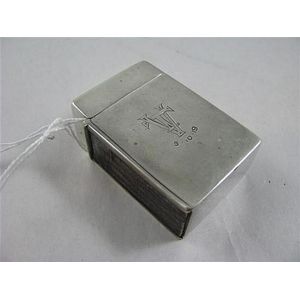Three Silver Boxes with Cedar Lining and Malachite Decoration
You must be a subscriber, and be logged in to view price and dealer details.
Subscribe Now to view actual auction price for this item
When you subscribe, you have the option of setting the currency in which to display prices to $Au, $US, $NZ or Stg.
- Engine Turned - Engine turning is a decorative technique used on metal surfaces to create intricate curving or geometric pattern. The process involves cutting a series of lines into the surface of the metal using a rose engine or decoration lathe which rotates the metal as it cuts, allowing the operator to create a repeating pattern that covers the entire surface. The resulting surface has a shimmering, reflective quality that is often described as "engine turned." Where an engine turned item has been enamelled, the term used to describe the decoration is usually guilloche.
Engine turning was originally developed to decorate metal objects such as firearms, scientific instruments, and other metal objects that required precise and elegant design. - Malachite - Malachite is bright copper-green coloured stone with concentric layers which displays distinct contrasting veinings. It has been valued in the past for making or decorating small precious objects such as clocks, jewellery, dishes and so. In the Orient it was used for snuff bottles and in Russia and was favoured by the Faberge workshop. larger pieces were used for table tops.
The principal source of supply was Russia but it is to be found in other regions such as Southern Africa, Mexico, Australia and France.
Malachite glass is a manufactured material that was intended to resemble malachite, but often bears more resemblance to a veined coloured marble due to its lower gloss finish and lack of concentric layers. Malachite glass was manufactured by many glassworks in the 19th century including Loetz in Austria and others in Bohemia and Davidson's Greener's and Sowerby in north eastern England.
It was particularly used for scent bottles, bowls, and small vases often decorated with nymphs.
Malachite glass has been manufactured continuously since the late nineteenth century, most is unmarked and it is difficult to distinguish the age or manufacturer of most commercial pieces.
Visually similar items

George V hallmarked sterling silver cigar box & cigarette case. Box, Birm 1919, makers mark rubbed. Dedication engraved to lid dated 1921. Wood lined interior. Plus cigerette case, Birm 1922, monogrammed, height 6 cm width 18 cm depth 15 cm weight 855g (bo

A Chinese square ink stone, 15.6 cm x 5.9 cm x 2.2 cm. Provenance: Private collection NSW, Purchased 20 years ago in Wyndham Street, Hong Kong

A Stirling silver matchbox, lidded. Accommodates tray from a commercial box of matches, commercial striker fitted to side below the hinged lid, engraved with mongram 'T V' 5.10.19. Marked for W J Proud, Sydney.

Victorian hallmarked sterling silver snuff box, hallmarked Birmingham (date mark rubbed); maker Thomas Shaw. Gilded interior. Top embossed with hunting scene; bottom with verse 'Friendship's voiceË a fragrant story'. Length 7.5 cm. Weight 105g
